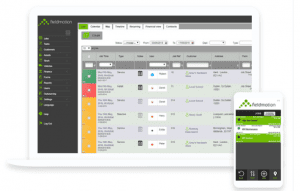In the service industries, workflow management involves setting up a flow from job to job based on overall plans, or whatever was discovered during each step.
The simplest example might be a flow where one type of job is always followed by another. For example, when a pipe needs to be laid in the ground, the flow will involve planners getting permission from various authorities, followed by diggers creating a trench and shoring it, followed by the installation of the pipe, then the joining of the pipe to the existing network, filling in the trench, and then resurfacing.
Each of these steps might involve a different team. FieldMotion’s field service software lets you create a sequence of jobs by using forms that, on-complete, create follow-on jobs set to start either immediately, or you can even set a delay in cases where you may need to allow time for settling or drying, etc.
A more complex example might be one where the follow-up jobs might be different depending on the conditions found during the current job.
The pipe-laying sequence, for example, might also take account of what to do if the trench-diggers uncover pre-existing wires or pipes. Obviously, that would affect the sequence of jobs, so a new follow-up job (investigation) would need to be dynamically created based on the discovery.
FieldMotion lets you create workflow logic based on data recorded in the job. This is especially useful for cases where some decision-making is possible based on exact numbers entered. For example, in the case of medical checkups, you may want a doctor to be booked automatically if the checkup notes a too-low (or too-high) blood pressure.
Sometimes even the job itself might change mid-job based on what data is entered. Consider the case of a form you are filling which asks for the details of three objects that are on-site. You fill in object one, and object two, but there is no third. Well, the form might have a clause for this, where you answer “Is the third object available for inspection” with “no”, and this automatically replaces the followup questions with different questions asking why the object is not there, or maybe it just skips on ahead to the next section altogether.
We call that kind of workflow “skip logic”, but it’s really just a small version of the larger jobs-based system of managing workflow.
The point of all of this is to reduce the administration needed on-the-job. Your field workers don’t need to be trained how to decide what course of action to take next if the system knows how to do it itself. Field service engineer software such as FieldMotion can dynamically assign work as existing job orders are completed.
If you’d like to talk to FieldMotion (one of the largest UK service management software companies!) about how we can help you with your own field service workflow, please contact us. Here are some field service management software reviews of us (Capterra, Finances Online) that you might read to help you decide.


